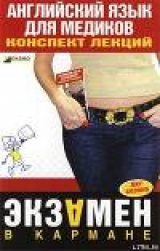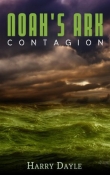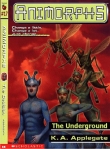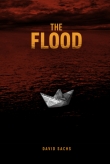
Текст книги "Английский язык для медиков: конспект лекций"
Автор книги: Елена Беликова
Жанры:
Языкознание
,сообщить о нарушении
Текущая страница: 9 (всего у книги 12 страниц)
ЛЕКЦИЯ № 32. Respiratory bronchioles
Respiratory bronchioles are areas of transition (hybrids) between the conducting and respiratory portions of the airways. In addi tion to the typical bronchiolar epithelium of the terminal bron chioles, these passageways contain outpouchings of alveoli, which comprise the respiratory portion of this system.
Terminal bronchioles give rise to respiratory bronchioles.
Respiratory bronchioles branch to form two to three alveolar ducts, which are long sinuous tubes.
Alveolar sacs are spaces formed by two or more conjoined alveoli. They are lined by the simple squamous alveolar epithe lium. Alveoli are the terminal, thin-walled sacs of the respiratory tree that are responsible for gas exchange. There are approximately 300 million alveoli per lung, each one 200-300 mm in diameter. Blood-air interface. Oxygen in the alveoli is separated from hemoglobin in the red blood cells of alveolar capillaries by five layers of membrane and cells: the alveolar epithelial cell (api cal and basal membranes) and its basal lamina, the basal lami na of the capillary and its endothelial cell (basal and apical membranes), and the erythrocyte membrane. The total thick ness of all these layers can be as thin as 0,5 mm.
Alveolar epithelium contains two cell types. Type I cells completely cover the alveolar luminal surface and provide a thin surface for gas exchange. This simple squamous epithelium is so thin (-25 nm) that its details are beyond the resolution of the light microscope.
Type II cells are rounded, plump, cuboidal-like cells that sit on the basal lamina of the epithelium and contain mem brane-bound granules of phospholipid and protein (lamel lar bodies). The contents of these lamellar bodies are secreted onto the alveolar surface to provide a coating of surfactant that reduces alveolar surface tension.
Alveolar macrophages (dust cells) are found on the surface of the alveoli.
Derived from monocytes that extravasate from alveolar capillaries, alveotar macrophages are part of the mononu – clear phagocyte system. Dust cells, as their name implies, continuously remove parti cles and other irritants in the alveoli by phagocytosis.
New words
respiratory bronchioles – дыхательные бронхиолы
transition – переход hybrids – гибриды
respiratory portions – дыхательные части
airways – воздушные трассы
in addition – кроме того
bronchiolar – бронхиолярный
terminal bron chioles – предельные бронхиолы
passageway – проходы
tocomprise – включить
branch – ветвь
ducts – трубочки
sinuous tubes – извилистые трубы
to be lined by – быть выровненным
simple – простой
thin-walled – окруженный тонкой стеной sacs – мешочки
respiratory tree – дыхательное дерево
responsible – ответственный
approximately – приблизительно
hemoglobin – гемоглобин
apical – апикальный basal – основной
Мало:
little (единственное число)
few (множественное число)
Переведите на английский язык следующие пары слов.
Мало домов, мало чая, мало чашек, мало яблок, мало окон, мало бумаги, мало кофе, мало статей, мало радости, мало супу, мало деревьев, мало травы, мало детей, мало игрушек, мало света, мало парт, мало колбасы, мало сока, мало книг, мало цветов, мало соли, мало друзей, мало дворцов.
Вставьте little или few.
1. I have… time.
2. He has. English books.
3. There is. in my pen. Have you got anytink?
4. There aren't… bear in the zoo.
5. Tom Canty was the son of poor parents and had very. clothes.
6. There is too… soup in my plate.
7. The. children returned from the wood very sad.
8. There is too. light in the room.
9. There are very. people in the room.
10. There are. vegetables in the basket.
Answer the questions.
1. What are respiratory bronchioles?
2. Between what are there areas of respiratory bronchi?
3. What the passageways xontain?
4. What comprises the respiratory portion of the system?
5. What bronchioles give to respiratory bronchioles?
6. What are long sinuous tubes?
7. What are alveolar sacs?
8. How are alveolar sacs lined by?
9. What are alveolar sacs formed by?
10. How many alveoli per lung are there?
Make the sentences of your own using the new words (10 sentences).
Make the sentences of your own using: little, few (10 sentences).
Find one word, which is a little bit different in meaning from others (найдите одно слово, которое немного отличается от других по смыслу):
1) a) part; b) complete; c) portion;
2) a) skin; b) breastbone; c) tissue;
3) a) hearing; b) ear; c) breathing;
4) a) fever; b) temperature; c) health;
5) a) neck; b) bronchi; c) trachea.
ЛЕКЦИЯ № 33. Pleura
Visceral pleura is a thin serous membrane that covers the outer surface of the lungs. A delicate connective tissue layer of collagen and elastin, containing lymphatic channels, vessels, and nerves, supports the membrane. Its surface is covered by simple squamous mesotheli-um with microvilli.
Parietal pleura is that portion of the pleura that continues onto the inner aspect of the thoracic wall. It is continuous with the visceral pleura and is lined by the same mesothelium.
Pleural cavity is a very narrow fluid-filled space that contains mo-nocytes located between the two pleural membranes. It contains no gases and becomes a true cavity only in disease (e. g., in pleural infection, fluid and pus may accumulate in the pleural space). If the chest wall is punctured, air may enter the pleural space (pneumothorax), breaking the vacuum, and allowing the lung to recoil. Parietal pleura lines the inner surface of the thoracic cavity; visceral pleura follows the contours of the lung itself.
Pleural cavity: The pleural cavity is the space between the parietal and viscer al layers of the pleura. It is a sealed, blind space. The intro-duc tion of air into the pleural cavity may cause the lung to col lapse (pneumothorax).
It normally contains a small amount of serous fluid elaborated by mesothelial cells of the pleural membrane.
Pleural reflections are areas where the pleura changes direction from one wall to the other. The sternal line of reflection is where the costal pleura is con tinuous with the mediastinal pleura behind the sternum (from costal cartilages 2-4). The pleural margin then passes in-feriorly to the level of the sixth costal cartilage. The costal line of reflection is where the costal pleura becomes continuous with the diaphragmatic pleura from rib 8 in the midclavicular line, to rib 10 in the midaxillary line, and to rib 12 lateral to the vertebral column. Pleural recesses are potential spaces not occupied by lung tissue except during deep inspiration. Costodiaphragmatic recesses are spaces below the inferior borders of the lungs where costal and diaphragmatic pleura are in contact. Costomediastinal recess is a space where the left costal and mediastinal parietal pleura meet, leaving a space due to the cardiac notch of the left lung. This space is occupied by the lingula of the left lung during inspiration.
In nervation of the parietal pleura: The costal and peripheral portions of the diaphragmatic pleu ra are supplied by intercostal nerves.
The central portion of the diaphragmatic pleura and the medi asti-nal pleura are supplied by the phrenic nerve.
New words
visceral – висцеральный
pleura – плевра
delicate – тонкий
collagen – коллаген
elastin – эластин
containing – содержание
lymphatic channels – лимфатические сосуды
nerves – нервы
to support – поддерживать
covered – покрытый
squamous – чешуйчатый
microvilli – микроворсинки
parietal pleura – париетальная плевра
onto aspect – в аспекте
visceral pleura – висцеральная плевра
inspiration – вдохновение
costal – реберный
Степени сравнения прилагательных Таблица 4.

Особые случаи образования степеней сравнения Таблица 5.

Образуйте сравнительную и превосходную степень следующих прилагательных. Не забудьте употреблять определенный артикль перед превосходной степенью прилагательных.
Hot, long, short, clever, silly, great, red, black, white, thin, thick, fat, nice, warm, cold, merry small, tall, high, weak, strong, heavy, light, green, dry, clean, dirty, wide, deep, brave.
Переведите на английский язык.
Старый, старше, самый старый, самый старший, мой старший брат, мой старый друг, дальше, самый дальний, самый длинный, короче, счастливый, счастливее, самый счастливый, самый лучший, самый черный, длиннее, хуже, лучше, теплее, ее лучший друг, ее младший сын, его старший сын.
Answer the questions.
1. What is visceral pleura?
2. Is visceral pleura a thin serous membrane or not?
3. What contains lymphatic channels, vessels, and nerves?
4. What covers delicate connective tissue layer?
5. Which portion of the pleura is parietal pleura?
6. What kind of space is pleural cavity?
7. What do pleural cavity contain?
8. In which way air may enter the pleural space?
9. What do normally contain a small amount of serous fluid?
10. What is supplied by intercostal nerves?
Make the sentences of your own using the new words (10 sentences).
Find the verb to be in the text. Explain why it is used in such a way?
ЛЕКЦИЯ № 34. Nasal cavities
The anatomical structures that play a central role in the res piratory system are located in the head and neck as well as the thorax.
Nasal cavities are separated by the nasal septum, which consists of the vomer, the perpendicular plate of the ethmoid bone, and the septal cartilage. The lateral wall of each nasal cavity features three scroll-shaped bony structures called the nasal conchae. The nasal cavities communicate posteriorly with the nasopharynx through the choanae. The spaces inferior to each concha are called meatus. The paranasal sinuses and the nasolacrimal duct open to the meati. The inferior concha is a separate bone, and the superior and middle conchae are parts of the ethmoid bone.
Inferior meatus. The only structure that opens to the inferior meatus is the nasolacrimal duct. This duct drains lacrimal fluid (i. e., tears) from theTneaTaraspect of the orbit to the nasal cavity.
Middle meatus: the hiatus semilumaris contains openings of frontal and maxillary sinuses and americy ethmoidal air cells. The bulla ethmoidalis contains the opening for'the middle ethmoidal air cells.
Superior meatus contains an opening for thffposterior ethmoidal air cells.
Sphenoethmoidal recess is located above the superior concha and contains an opening for the sphenoid sinus.
Innervation: Somatic innervation. General sensory information from the lateral wall and septum of the nasal cavity is conveyed to the CNS by branches of V, and V2.
Autonomic innervation. Preganglionic parasympathetic fibers destined to supply the glands of the nasal mucosa and the lacrimal gland travel in the nervus intermedius and the greater superficial petrosal branches of the facial nerve (CN VII). These fibers synapse in the pte-rygopalatine ganglion, which is located in the pterygopalatine fossa. Postganglionic fibers traveling to the mucous glands of the nasal cavity, paranasal air sinuses, hard and soft palate, and the lacrimal gland follow branches of V2 and in some cases V1, to reach their destinations.
New words
anatomical – анатомический play – игра
central role – центральная роль
respiratory system – дыхательная система
head – голова
neck – шея
nasal cavities – носовые впадины
to be separated – быть отделеным
the perpendicular plate – перпендикулярная пластина
ethmoid – решетчатый
septal – относящийся к перегородке
nasal conchae – носовой раковина
communicate – взаимодействовать
posteriorly – сзади
paranasal – параносовой
sinuses – пазухи
nasolacrimal – назолакримальный
duct – трубочка
drain – проток
tears – слезы
orbit – орбита
hiatus – пауза
maxillary – верхнечелюстной
bulla – пузырь
Поставьте глагол to be в правильную форму, заполнив пропуски.
1. I… a pupil.
2. My father… not a teacher, he… a scientist.
3… your sister a teacher?
4. Mary. a painter.
5… they at home?
6. My father. a worker.
7. She… at work.
8.. you a doctor?
9. He… a pilot.
10. We… students.
11. They… carpenters.
12… they at home?
13. they… not at home
14. He… at work.
15… your sister a typist?
16… your brother at school?
17… your sister in the cabinet?
18. My sister… at home.
19… this your cat?
20. She… an actress.
21. This… my bag.
22. He… professor.
23. Helen… a singer.
24… you an engineer?
25. He… Russian.
Переведите на английский язык, употребляя глагол to be в Present Simple.
1. Я ученик. Я в школе.
2. Мой брат художник. Он не инженер.
3. Моя сестра на работе. Она врач.
4. Он студент, а не учитель.
5. Вы студент? – Нет, я ученик.
6. Моя сестра дома. Она больна.
7. Мы не в школе. Мы дома.
8. Мой брат ученик. Он в школе.
9. Ваша мама дома? – Нет, она на работе.
10. Ваш двоюродный брат дома? – Нет, он в школе.
11. Твоя сестра здорова сейчас? – Да, она здорова.
12. Ваша сестра учительница? – Нет, она студентка.
13. Твой папа на работе? Нет, он на даче.
14. Твоя сестра машинистка? – Да. Она машинистка.
15. Моя мама не учительница. Она врач.
16. Чья это ручка? – Это моя ручка.
17. Чья это книга? – Это ваша книга.
18. Чей это стол? – Это стол моего брата.
19. Чья это сумка? – Это сумка моей мамы.
20. Чей это карандаш? – Это карандаш моей сестры.
21. Это твоя тетрадь? – Да, это моя тетрадь.
22. Это тетрадь твоего брата? – Нет, это моя.
23. Где ваш стол? – Он посередине комнаты.
24. Где твоя ручка? – Она в моем кармане.
25. Где твоя тетрадь? – Она на столе.
26. Мой дедушка не ученый, он геолог.
Answer the questions.
1. What is the cell consists of?
2. What is a membrane?
3. Is cell the smallest independent unit of the body?
4. What can be grown in test – tubes?
5. What can various tissues form, when they are together?
6. What are the organ system consist of?
7. What are cell characterized by?
8. What are cell organelles?
9. What ate membranes?
10. What is the cytoplasm?
Make the sentences of your own using the new words (10 sentences).
Find the verb to be in the text. Explain why it is used in such a way?
Find one word, which is a little bit different in meaning from others (найдите одно слово, которое немного отличается от других по смыслу):
1) a) cell; b) body; c) flower;
2) a) life; b) plate; c) people;
3) a) test-tube; b) microscope; c) pen;
4) a) curtain; b) body; c) tissue;
5) а) spoon; b) kidney; c) liver.
ЛЕКЦИЯ № 35. Pharynx and related areas
The pharynx is a passageway shared by the digestive and respira tory systems. It has lateral, posterior, and medial walls through out, but is open interiorly in its upper regions, communicating with the nasal cavity and the oral cavity. The anterior wall of the laryngopharynx is formed by the larynx. The pharyngeal wall con sists of a mucosa, a fibrous layer, and a muscularis, which is com posed of an inner longitudinal layer (i. e., stylopharyngeus, palatopharyngeus, salpingopharyn-geus) and an outer circular layer (i. e., superior, middle, inferior constrictor muscles).
Nasopharynx is the region of the pharynx located directly poste rior to the nasal cavity. It communicates with the nasal cavity through the choanae (i. e., posterior nasal apertures).
The torus tubarius is the cartilaginous rim of the auditory The pha-ryngeal recess is the space located directly above and behind the torus tubarius; it contains the nasopharyngeal tonsil. The salpingopharynge-al fold is a ridge consisting of mucosa and the underlying salpingopha-ryngeus muscle, which runs down the wall of the pharynx from the torus tubarius.
Oropharynx is the region of the pharynx located directly posterior to the oral cavity. It communicates with the oral cavity through a space called the fauces. The fauces are bounded by two folds, consisting of mucosa and muscle, known as the anterior and posterior pillars.
The anterior pillar of the fauces, also known as the palatoglossal fold, contains the palatoglossus muscle.
The posterior pillar of the fauces, also known as the palatopharyn-geal fold, contains the palatopharyngeus muscle. The tonsillar bed is the space between the pillars that houses the palatine tonsil.
Laryngopharynx is the region of the pharynx that surrounds the larynx. It extends from the tip of the epiglottis to the cricoid car tilage. Its lateral extensions are known as the piriform recess.
Oral cavity: the portion of the oral cavity that is posterior to the lips and anterior to the teeth is called the vestibule. The oral cavi ty proper has a floor formed by the mylohyoid and geniohyoid muscles, which support the tongue. It has lateral walls, consisting of the buccinator muscles and buccal mucosa, and a roof formed by the hard palate anteriorly and the soft palate posteriorly. Its posterior wall is absent and is replaced by an opening to the oropharynx, which is flanked by the pillars of the fauces.
The palate separates the nasal and oral cavities.
Hard palate is formed by the palatine process of the maxilla and the horizontal palate of the palatine bone. Its mucosa is supplied with sensory fibers from CN V2.
Soft palate consists of a fibrous membrane, the palatine aponeuro-sis, covered with mucosa. The portion that hangs down in the midline is the uvula, which contains the musculus uvulae. Two additional muscles (i. e., levator palati, tensor palati) insert into the palatine aponeurosis.
The tongue is a mobile, muscular organ necessary for speech. It is divisible into an anterior two-thirds and a posterior one-third by the sulcus terminalis.
Muscles of the tongue. These include the intrinsic and extrinsic muscles (i. e., palatoglossus, stylogiossus, hyoglos – sus, genioglos-sus). All of the muscles are innervated by CN XII except the palatoglossus, which is supplied by CN X. Arterial supply: The tongue is supplied by the lingual branch of the external carotid aitery.
Venous drainage. The lingual veins, which lie on the under-surface of the tongue, drain to the internal jugular veins.
Lymphatic drainage. The tip of the tongue drains to the submental nodes, and the remainder of the anterior two-thirds drains first to sub-mandibular, then to deep cervical nodes. The posterior one-third drains directly to deep cervi cal nodes.
New words
shared – разделенный
digestive – пищеварительный
anteriorly – раньше
upper – верхний
regions – области
communicating – взаимодействие
oral cavity – полость рта
anterior wall – передняя стенка
pharyngeal – глоточный
mucosa – слизистая оболочка
fibrous layer – волокнистый слой
longitudinal – продольный
circular layer – круглый слой
superior – выше
middle – середина
posterior nasal apertures – задние носовые апертуры
torus tubarius – трубный валик
auditory space – носоглоточный
nasopharyngeal tonsil – миндалина
fold – сгиб
Спряжение глагола to be (быть) в Past Simple Tense
(Past Indefinite Tense) Таблица 6.

Переведите на английский язык, используя таблицу 6.
1. Я был учеником.
2. Он был летчиком.
3. Она была доктором.
4. Мы были школьниками.
5. Они были рабочими.
6. Ты был рабочим.
7. Они были учениками.
8. Я был дома.
9. Он был в школе
10. Она была в кино?
11. Мы были в парке.
12. Они были в театре?
13. Она была молодая в то время?
14. Он был старый.
15. Она не была учительницей.
16. Они были сильные.
17. Она была больна.
18. Вы были больны?
19. Он был болен?
20. Я не был болен.
21. Я был болен вчера.
22. Она не была больна.
23. Мы были в кино.
24. Они не были в кино.
25. Они не были в школе.
26. Они были дома.
27. Вы были в парке вчера?
28. Он был в школе вчера?
29. Он был рабочим.
30. Она была актрисой.
Answer the questions.
1. What is the pharynx?
2. What shares the pharynx?
3. What has the pharynx?
4. What forms the anterior wall of the laryngopharynx?
5. What the pharyngeal wall con sists of?
6. What is nasopharynx?
7. Where is nasopharynx located?
8. What is the torus tubarius?
9. What is located directly above and behind the torus tubarius?
10. What is located between the pillars that houses the palatine tonsil?
Make the sentences of your own using the new words (10 sentences). Find the verb to be in the text. Explain why it is used in such a way?
ЛЕКЦИЯ № 36. Oral cavity
The oral cavity forms in the embryo from an in-pocketing of the skin, stomodeum; it is, thus, lined by ectoderm. Functionally, the mouth forms the first portion of both the digestive and respiratory systems. Various special structures are found in, or associated with, the mouth.
In humans the margins of the lips mark the junction between the outer skin and the inner mucous lining of the oral cavity. The roof of the mouth consists of the hard palate and, behind this, the soft palate which merges into the oropharynx. The lateral walls consist of the distensible cheeks. The floor of the mouth is formed principally by the tongue and the soft tissues that lie between the two sides of the lower jaw, or mandible.
The tongue, a muscular organ in the mouth, provides the sense of taste and assists in chewing, swallowing, and speaking. It is firmly anchored by connective tissues to the front and side walls of the pharynx, or throat, and to the hyoid bone in the neck.
The posterior limit of the oral cavity is marked by the fauces, an ap-perture which leads to the pharynx. On either side of the fauces are two muscular arches covered by mucosa, the glossopalatine and pharyngo-palatine arches; between them lie masses of lymphoid tissue, the tonsils. Hiese are spongy lymphoid tissues composed mainly of lympho-cytic cells held together by fibrous connective tissue. Suspended from the posterior portion of the soft palate is the soft retractable uvula. The palate develops from lateral folds of the primitive upper jaw. The palate of mammals consists of two portions. The hard palate, more anterior in position, underlies the nasal cavity. The soft palate hangs like a curtain between the mouth and nasal pharynx.
The hard palate has an intermediate layer of bone, supplied anteriorly by paired palatine processes of the maxillary bones, and posteriorly by the horizontal part of each palate bone. The oral surface of the hard palate is a mucous membrane covered with a stratified squamous epithelium. Anteriorly in humans there are four to six transverse palatine ridges: these diminish in prominence between fetal life and old age. A submucosal layer contains mucous glands and binds the membrane firmly to the periosteum of the bony component. Above the bone is the mucous membrane that forms the floor of the nasal cavity.
The soft palate is a backward continuation from the hard palate. Its free margin connects on each side with two folds of mucous membrane, the palatine arches, enclosing a palatine tonsil. In the midline the margin extends into a fingerlike projection called uvula. Both the hard and soft palate bear a seam, or raphe, along the midline. The oral side of the soft palate continues as the covering of the hard palate, and the submucosa contains mucous glands. The intermediate layer is a sheet of voluntary muscle.
Besides separating the nasal passages from the mouth, the hard palate is a firm plate, against which the tongue manipulates food. In swallowing and vomiting the soft palate is raised to separate the oral from the nasal portion of the pharynx. This closure prevents food from passing upward into the nasopharynx and nose. The closing action also occurs in speech.
New words
oral cavity – полость рта
forms – формы
embryo – эмбрион
in-pocketing – в присваивании
functionally – функционально
mouth – рот
special – особенный
structures – структуры
associated – связанный
humans – люди
margins – края
lips – губы
mark – марка
junction – соединение
hard – трудно
merges – слияния
distensible – растяжимый
cheeks – щеки
principally – преимущественно
tongue – язык
taste – вкус
to assists – помогать
chewing – жевание
swallowing – глотание
speaking – разговор
limit – предел
Спряжение глагола to be (быть) в Future Simple Tense
(Future Indefinite Tense) Таблица 7

Вставьте глагол to be в Present, Past или Future Simple.
1. My father… a teacher.
2. He… a pupil twenty years ago.
3. I… a doctor when I grow up.
4. My sister… not… at home tomorrow.
5. She… at school tomorrow.
6… you… at home tomorrow?
7… your father at work yesterday?
8. My sister… ill last week.
9. She… not ill now.
10. Yesterday we… at the theatre.
11. Where… your mother now? – She… in the kitchen.
12. Where… you yesterday? – I… at the cinema.
13. When I come home tomorrow, all my family… at home.
14… your little sister in bed now? – Yes, she…
15… you little… at school tomorrow? – Yes I…
16. When my granny… young, she… an actress.
17. My friend… in Moscow now.
18. He… in St. Petersburg tomorrow.
19. Where… your books now?
20. They… in my bag.
Answer the questions.
1. What the oral cavity forms?
2. What is lined by ectoderm?
3. Does mouth form the first portion of both the digestive and respiratory systems?
4. What does the roof of the mouth consist of?
5. What is situated behind hard palate?
6. What do the lateral walls consist of?
7. What is the floor of the mouth formed principally by?
8. What does the palate develop?
9. What is the intermediate layer?
10. In what cases is the soft palate raised to separate the oral from the nasal portion of the pharynx?
Make the sentences of your own using the new words (10 sentences).
Find the verb to be in the text. Explain why it is used in such a way?








